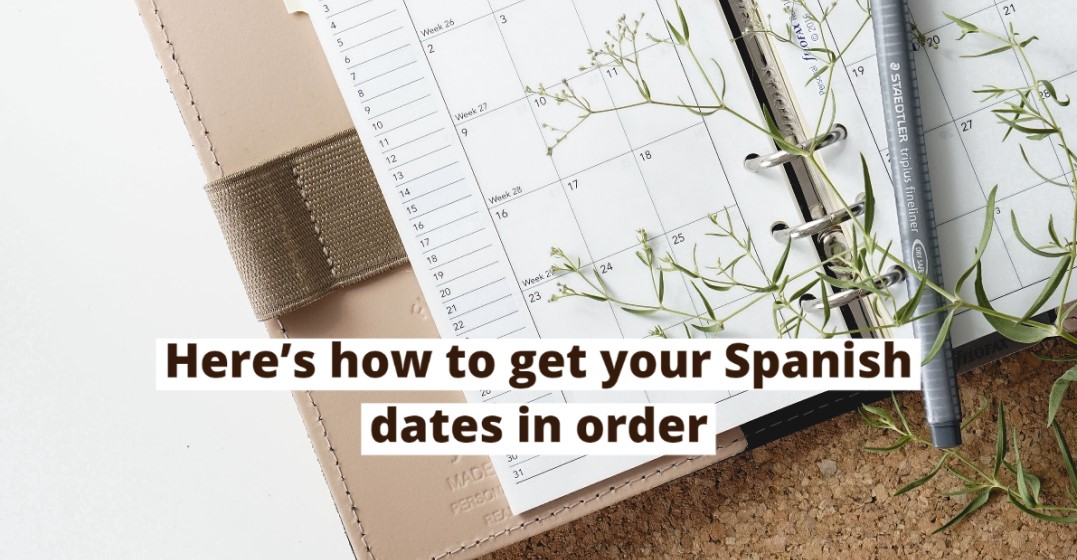by Jakob Straub
Updated on January 9, 2024
How do you say the date and month in Spanish? You have to not only know your numbers but also be able to pronounce the months correctly. Then there are a few differences between how the Spanish write and say dates in general, but don’t worry, in the following, we’ll tell you all you need to know to say dates like a local in Spain.
If you have a bit of a knack for Spanish pronunciation, the months should pose no particular problem for you. The following table will give you an overview of the correct pronunciation. For the International Phonetic Alphabet transcription, the Castilian way of saying the month always comes first before the Latin American way. Note that the month is not capitalized unless the word is at the beginning of a sentence.
| MONTH | SPA | IPA | |
| 1 | enero | eh-neh-roh | /eˈneɾo/ |
| 2 | febrero | feh-breh-roh | /feˈbɾeɾo/, [feˈβɾeɾo] |
| 3 | marzo | mahr-thoh | /ˈmarθo/, /ˈmarso/ |
| 4 | abril | ah-breel | /aˈbɾil/, [aˈβɾil] |
| 5 | mayo | mah-yoh | /ˈmaɟ͡ʝo/, [ˈmaʝo] |
| 6 | junio | hoo-nyoh | /ˈxunjo/ |
| 7 | julio | hoo-lyoh | /ˈxuljo/ |
| 8 | agosto | ah-gohs-toh | /aˈɡosto/, [aˈɣost̪o] |
| 9 | septiembre | sehp-tyehm-breh | /sebˈtjembɾe/, [seβˈt̪jẽmbɾe] |
| 10 | octubre | ohk-too-breh | /oɡˈtubɾe/, [oɣˈt̪uβɾe] |
| 11 | noviembre | noh-byehm-breh | /noˈbjembɾe/, [noˈβjẽmbɾe] |
| 12 | diciembre | dee-thyehm-breh | /diˈθjembɾe/, [d̪iˈθjẽmbɾe]/diˈsjembɾe/, [d̪iˈsjẽmbɾe] |
When saying the date in Spanish, the day precedes the month. “April tenth” or “the tenth of April” therefore becomes “diez de abril”, which literally translates to “ten of April”.
For saying the entire date in Spanish including the year, you can use a simple formula:
You can use del instead of de before the year, because it indicates the omitted año (for year). Note that when you announce a date of the current year, you’d commonly leave out announcing the year.
Here are some more examples:
These are all the numbers you need to know when saying dates in Spanish:
| 1 – one – primero (exception!) | 11 – eleven – once | 21 – twenty one – veintiuno |
| 2- two – dos | 12 – twelve – doce | 22 – twenty two – veintidós |
| 3 – three – tres | 13 – thirteen – trece | 23 – twenty three – veintitrés |
| 4 – four – cuatro | 14 – fourteen – catorce | 24 – twenty four – veinticuatro |
| 5 – five – cinco | 15 – fifteen – quince | 25 – twenty five – veinticinco |
| 6 – six – seis | 16 – sixteen – dieciséis | 26 – twenty six – veintiséis |
| 7 – seven – siete | 17 – seventeen – diecisiete | 27 – twenty seven – veintisiete |
| 8 – eight – ocho | 18 – eighteen – dieciocho | 28 – twenty eight – veintiocho |
| 9 – nine – nueve | 19 – nineteen – diecinueve | 29 – twenty nine – veintinueve |
| 10 – ten – diez | 20 – twenty – veinte | 30 – thirty – treinta |
| 31 – thirty one – treinta y uno |
Note that unlike English, Spanish uses cardinal numbers instead of ordinal numbers. The exception is the first of the month uses the ordinal number primero, first. However, if you really want to emphasize the ordinal aspect of a day, you can do so in Spanish: nos vemos el quinto de mayo, which translates to “see you on the fifth of May” – but it is rather unusual in daily use.
In conversation, when you say a date in Spanish, the number corresponding to the date will always come first, followed by the month and then the year, in case you need to state that as well.
For the notation of dates, you can choose between numerals only, or a mixture between numerals and words. If you express the date as just numbers, remember to always put the daay first: DD/MM/YYYY is the common form, though you might also encounter YYYY/DD/MM at times. Same as in English, you omit the zero for single digit days or months.
Mixing numerals and words means using a word for just the month (see our table above) and numbers to express day and year. This also happens to be a common way of writing the date in letters. Remember to NOT capitalize the month!
